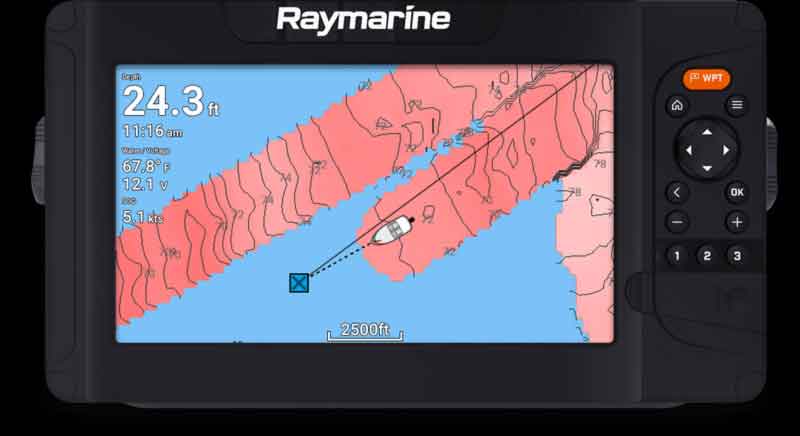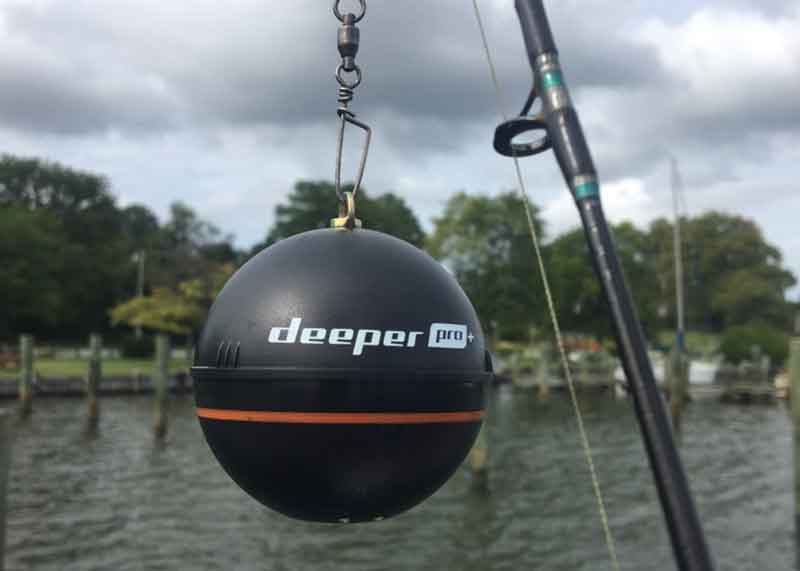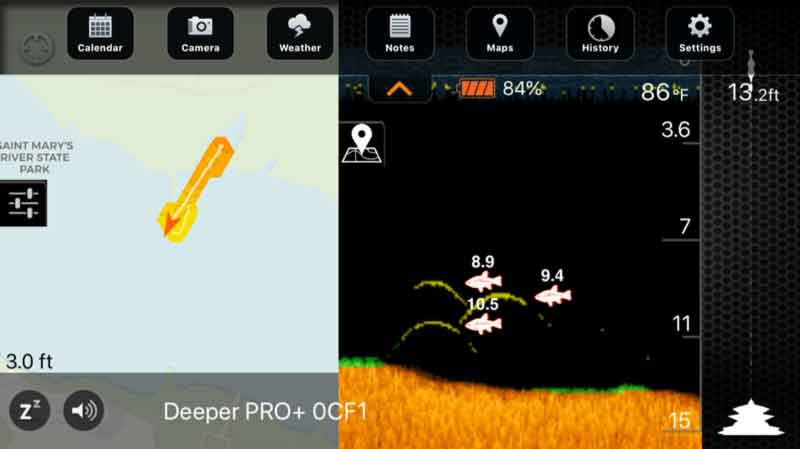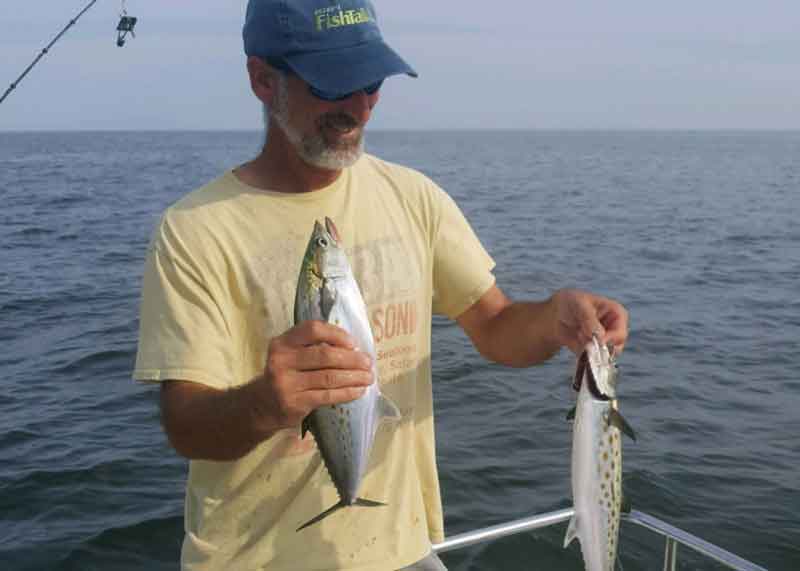Sure, we all hear about new electronics like high-tech side-looking fishfinders, 3-D views of what lays beneath the boat, and the amazing resolution of down-scanners. Just about everyone’s been exposed to the plethora of angler-assisting apps by now. And the application of virtual anchoring has become widespread among anglers. But there’s still some gee-wiz stuff out there that many of us either haven’t heard about, or haven’t considered as fish-catching tools. And that’s too bad, because for all its drawbacks modern tech can in fact help you catch more fish. Here are three little-known or under-utilized ways you can harness it to boost your catch rate.
Take a Bathy

Just about everyone who fishes from a boat uses a chartplotter, and often refers to the contour lines, depth soundings, and other bathymetric information. There’s just one problem: no matter how good your digital charts are, they aren’t perfect. In fact, the database for most bathymetrics all began with NOAA depth soundings, some of which are so old they date back to the days of lead-lines. Anyone with a good deal of experience can probably remember driving his or her boat right across one of those contour lines, and seeing nothing but smooth bottom – not to mention trying to find a charted wreck that’s not saved as a waypoint. Good luck with that.
The thing is, many of us could be vastly improving out bathymetric data as we cruise and as we fish. For a little over five years it’s been possible to set your chartplotter and GPS to work in concert with one another, constantly recording the pings from the transducer and GPS position data to update and re-draw your digital charts. True, early systems were a bit clumsy and you had to upload and download the recordings to a web site or the cloud. But tech advances at lightening speeds, and these days there are multiple ways to make it happen in the background with no additional effort on your part. If your MFD has WiFi it’s almost certainly a piece of cake; in some cases you can set an app on your phone to pair up with the MFD and fling the data around, and in other cases the unit can be set to initiate data-crunching when it comes within range of a hotspot. And some of the latest units to hit the market, like the Raymarine Element series, can perform the task in real-time with no added input from the user.
The first time I tested a unit with self-charting capabilities it was rather shocking to see just how wrong the original digital charts were. Contour lines were off by literally hundreds of feet in some areas at the mouth of the South River, and some charted obstructions were so far off-target as to be laughable.
Are there down sides? Of course – all tech is a PITA in one way or another. In this case, it’s a matter of figuring out how your system has to be set up to do this task. The steps vary quite a bit from manufacturer to manufacturer, but again, note that today’s systems aren’t nearly as clunky as they were just a few years ago. Still, some level of time-investment will be necessary. But just imagine how much more accurate your bathymetry could be for the areas you fish on a regular basis, much less what you can learn as you explore new spots. You’ll be able to view contour lines down to one-foot increments, see tiny bumps and ditches that are too subtle to show up on mass-market digital charts, and gain a much more accurate perspective of what the bottom really looks like where you fish. Do you think a difference like this could give you a leg up on the competition? Youbetcha – and if your unit has self-made charting capability that you’re not using, you’re missing out.
A Shore Thing: Deeper

You might not have a boat, but that doesn’t mean you can’t harness the tech found in a fishfinder. Deeper Smart Sonar lets you do just that. Small enough at just 3.5 ounces to cast from a fishing rod, it’s the perfect sonar for the shoreline fishermen. With a Wi-Fi range of 330 feet and the ability to transmit its imagery to your cell phone, simply cast the transducer out and retrieve it slowly back in. Whether you’re fishing from the shore, off a pier, a bridge, or from a small watercraft, with Deeper you can scan topography of your favorite fishing spot – and find the fish.
There are currently three models offered by Deeper, with a fourth coming soon. I tested the Deeper Pro+ at three of my go-to fishing spots, a local pond, pier, and lake. My first outing was at a local pier on Mill Creek. Easy enough, right? But first you’ll have to download the Deeper Smart Sonar app to your smart phone or other portable device.
I started by simply walking around the pier towing Deeper with one of my heavier catfish rods, spooled up with 30-pound braid fishing line. (Yea, I was terrified that I’d make a cast and watch the Deeper sail away!) If you were targeting crappie on an ultralight spinning rod you wouldn’t cast out 3.5-ounce bait, so plan ahead and bring a heavy rod for it. I scanned the perimeter of the outer reaches of the pier, marking fish as I went along. Putting Deeper aside, I then picked up my fishing rod and started making casts along the pier counting down to the depth where I marked – and then caught — plenty of fish.
Next, I tried casting Deeper into a pond. I chose Calvert Cliffs State Park, because I’ve always wanted to know how the bottom of the pond looks. But one thing that hadn’t occurred to me about the Deeper sonar was how the big splash was in a small pond. Yep, major disruption to the pond life. So take note that if you plan to scan a small pond, you may want to take the time to plot the pond out then wait a while or come back another time to do the fishing. But with a little planning you can do just that, because the Deeper app will hold the history of all of your previous sonar scans and you can review them whenever you like.
For my final test-outing I loaded up my kayak and headed to St. Mary’s lake. I attached Deeper to the Flexible Arm Mount that they sell for the sonar. As before, the Deeper sonar provided me with water depth, water temperature, and contour of the lake bottom. What was different on this outing is that I turned on the boat mode option in the app. The app then tracked my location on the lake, giving me access to all the data at a later time by using the Deeper Lakebook management platform, which is a web-based application.

My final thoughts on Deeper: it works, but it does have pros and cons as do all sonar devices and tech products.
Pros:
- Deeper offers a ton of information and training for their products on their website.
- The Lakebook management platform provides an interface where you can access all your data for planning your next outing or tracking your outings.
- You don’t need a boat to see fish and the topography of everything within casting distance.
- It’s flexible enough to use from shore, kayak, Jon boat, pier and/or bridge, and it can be used for ice fishing too.
Cons:
- I found the Deeper will drain your phone’s battery life, so plan ahead.
- It’s heavy so it makes a big splash and you will need a stout rod to cast it.
- Deeper is not complicated, but you will have to dedicate some time to learning the app and the online interface.
Check out the Deeper Sonar.
- By Eric Packard
The Automaton Advantage

Through the years I’ve run boats offshore with autopilots that worked great, some with autopilots that were temperamental, and some with no autopilot at all. And there’s no doubt that those long runs to the canyons are made a lot more leisurely if you don’t have to constantly baby the wheel. So during a big renovation and upgrade this past winter, I had a Si-Tex SP-110C added to my own boat. Knowing how much easier those epic-length cruises would be, I couldn’t wait for the chance to haul down to OC, launch the boat, and head for the deep.
Imagine my surprise when I learned that having an autopilot actually helped me catch more fish right here near home, on the Chesapeake Bay.
This summer’s magnificent run of Spanish mackerel deserves a lot of the credit for the discovery. I’m not usually big on trolling, but with mackerel swarming the waters and towing a spread of spoons behind planers unquestionable the most effective way to catch ‘em, troll I did. And I rapidly learned that using an autopilot while trolling will absolutely, positively help you catch more fish.
The first reason: tangles can be drastically reduced. With the SP-110C you can set a heading, then change course in one-degree increments by pressing the “jog” button left or right. Ten quick button-presses takes just a couple of seconds, and creates a 10-degree course-change. Steering strictly on autopilot, I learned that I could circle back on hotspots with a much smoother, more reliable rate of turn than can be accomplished by spinning the wheel by hand. Net result? Tangling the lines – something I usually accomplish in rather grand fashion while trolling – became rare. That meant I spent less time straightening out messes and re-rigging, and more time with all the lines effectively deployed.
Reason number two: I discovered I could actually fish, instead of focusing entirely on steering the boat. With a full and experienced crew this isn’t an issue. But multiple times this summer while taking out an inexperienced group or a very small crew, I hit the “auto” button and then rigged a line or reeled in a fish. I even found it possible to spend an afternoon trolling for mackerel alone. Yes, you do need to be careful to continually pay attention to what’s ahead of the boat and a potential pitfall is the temptation to pay too little attention to maintaining a good lookout. But without the autopilot (at least in my case) trolling alone simply wouldn’t have even been an option.
Yep, you know it, this is just a peek at a small selection of the tech out there that can help you catch more fish. But as you consider which goodies and gizmos are worth bothering with and which are more of a PITA than they’re worth, make sure to consider these three electronic options – because all of them can help you catch more fish.